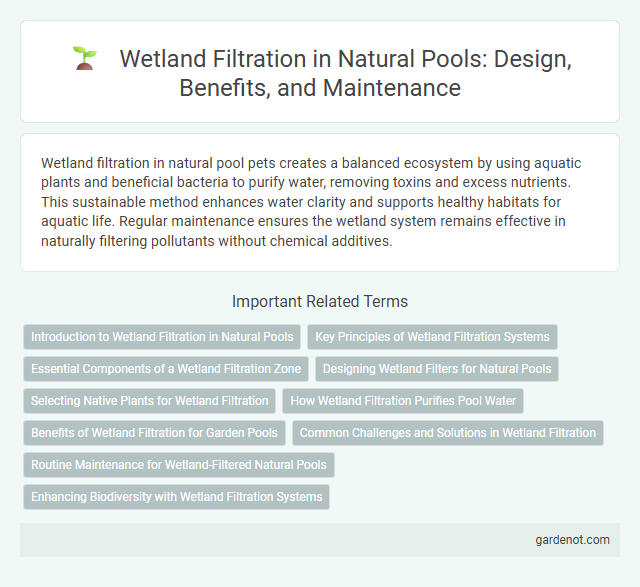Wetland filtration in natural pool pets creates a balanced ecosystem by using aquatic plants and beneficial bacteria to purify water, removing toxins and excess nutrients. This sustainable method enhances water clarity and supports healthy habitats for aquatic life. Regular maintenance ensures the wetland system remains effective in naturally filtering pollutants without chemical additives.
Introduction to Wetland Filtration in Natural Pools
Wetland filtration in natural pools utilizes aquatic plants and microorganisms to purify water through biological processes, mimicking natural wetlands. This method effectively removes pollutants such as nitrogen, phosphorus, and suspended solids, enhancing water clarity and ecosystem health. The integration of wetland filtration promotes a sustainable, chemical-free environment by supporting biodiversity and maintaining balanced nutrient cycles.
Key Principles of Wetland Filtration Systems
Wetland filtration systems utilize natural processes involving plants, microorganisms, and substrate to remove pollutants from water, enhancing water quality in natural pools. Key principles include sedimentation, where particles settle out; filtration through plant roots and substrate; and microbial degradation of organic compounds. These systems rely on maintaining optimal plant diversity and hydraulic flow rates to maximize contaminant removal efficiency.
Essential Components of a Wetland Filtration Zone
A wetland filtration zone in a natural pool integrates aquatic plants, porous substrate, and microbial biofilms to effectively remove contaminants and maintain water clarity. Essential components include emergent vegetation such as cattails and reeds, which absorb nutrients; a layered gravel and sand bed that traps sediments; and diverse microbial communities that break down organic pollutants. This symbiotic system enhances water quality by facilitating natural filtration processes and supports a balanced aquatic ecosystem.
Designing Wetland Filters for Natural Pools
Designing wetland filters for natural pools involves integrating aquatic plants and a substrate layer to enhance biological filtration and nutrient absorption. Key parameters include selecting native macrophytes like cattails and reeds, optimizing flow rates to maximize contact time, and ensuring proper hydraulic retention to promote microbial activity. Effective wetland filtration contributes to maintaining water clarity and ecological balance by reducing organic matter and pollutants naturally.
Selecting Native Plants for Wetland Filtration
Selecting native plants for wetland filtration in natural pools enhances water purification by leveraging species adapted to local ecosystems. Plants like cattails, bulrushes, and water lilies efficiently absorb nutrients and filter pollutants, promoting balanced aquatic environments. Incorporating diverse native vegetation supports microbial activity essential for breaking down contaminants and maintaining water clarity.
How Wetland Filtration Purifies Pool Water
Wetland filtration purifies pool water by utilizing a natural biofiltration process where aquatic plants, microorganisms, and substrate work together to remove contaminants. The roots of wetland plants absorb nutrients such as nitrogen and phosphorus, preventing algae growth and promoting clear water. Microbial activity in the wetland media breaks down organic pollutants and pathogens, resulting in a sustainable and chemical-free purification system for natural pools.
Benefits of Wetland Filtration for Garden Pools
Wetland filtration in garden pools enhances water quality by naturally removing pollutants such as nitrates, phosphates, and heavy metals through plant roots and microbial activity. This eco-friendly system promotes biodiversity by providing habitat for beneficial aquatic plants and microorganisms, which contribute to a balanced aquatic ecosystem. By reducing chemical usage and improving water clarity, wetland filtration supports sustainable pool maintenance and healthier swimming environments.
Common Challenges and Solutions in Wetland Filtration
Wetland filtration often faces challenges such as clogging from excessive sediment accumulation, fluctuating water levels that affect microbial activity, and invasive plant species disrupting native ecosystems. Effective solutions include regular sediment removal to maintain flow rates, designing adaptive water management systems to stabilize hydrological conditions, and implementing native vegetation planting to enhance natural filtration processes. Monitoring nutrient loads and promoting biodiversity further optimize the filtration efficiency and overall health of constructed wetland systems.
Routine Maintenance for Wetland-Filtered Natural Pools
Routine maintenance for wetland-filtered natural pools involves regular inspection and cleaning of biofiltration plants to ensure efficient pollutant absorption and nutrient cycling. Sediment buildup in gravel beds should be monitored and removed periodically to maintain optimal water flow and prevent clogging. Consistent removal of debris and dead plant matter supports healthy microbial activity essential for water purification and ecosystem balance.
Enhancing Biodiversity with Wetland Filtration Systems
Wetland filtration systems in natural pools create diverse habitats that support native aquatic plants, insects, and wildlife, significantly enhancing biodiversity. These systems utilize natural processes such as microbial activity and plant absorption to remove pollutants, improving water quality and fostering a balanced ecosystem. By mimicking natural wetlands, these filtration methods provide sustainable, chemical-free water purification while promoting ecological health and species richness.
Wetland filtration Infographic

 gardenot.com
gardenot.com